
What Is Customer Retention? 13 Winning Strategies To Retain Your Audience In 2025
New customers discovering your brand, visiting product pages, and perhaps in the mood for impulse buying. That’s the dream, right? Yes, it’s probably the first thing that comes to mind when thinking of revenue-driving tactics. But there’s one that’s more affordable, and that’s customer retention.
However, affordability isn’t the only reason to keep existing customers around.
Think of it this way: Do you prefer having new visitors who don’t know you? Or do you want Tom, your loyal customer, to place his 5th order for this month?
Surely, you’d pick Tom. A loyal customer who trusts your brand and has already seen how your products or services serve him. So, while customer acquisition is essential for short-term goals, retention ensures continuous business growth.
Today, you’ll learn why customer retention matters, how to calculate your repeat purchase rate, and the best strategies to increase it.
One-time visitors click, happy customers stick
Deliver personalized emails that keep your audience around.
Join MoosendWhat Is Customer Retention?
Customer retention is a process that businesses use to motivate existing customers to keep buying their products/services over a period of time.
It’s based on consistent and meaningful communication and impeccable customer service so you can build lasting relationships with your audience.
Just one loyal customer who returns to your products or services is likely to make a greater impact on your sales and marketing strategy compared to a few one-time buyers.
Following up, we’ll see the main reasons to think of customer retention as a top priority.
The Importance of Customer Retention
Customer retention isn’t just another metric. Far from that, it’s about:
- Brining more revenue in: Ongoing customer satisfaction means people think of your brand each time they want to get the same (or even better) outcome. So, they’ll spend more on your products/services over time. Also, you have more chances of convincing them to purchase additional products by using upselling or cros-selling.
- Boosting customer loyalty: Repeat customers are usually satisfied customers that find value in your offers. So, they’re less likely to switch to a competitive brand. In fact, 72% of consumers who trust a brand say they’ll stay loyal to it, even in cases of limited product availability or higher pricing.
- Driving customer acquisition: Another thing happy customers are great at is doing word-of-mouth marketing for you: recommending you to their friends, sharing your content on social media, and even creating social proof like testimonials or case studies.
- Making targeting easier: Existing customers know your products or services, as well as why they’re worth buying. Also, their buying history and overall engagement with your brand gives you better insights into their likes and interests. In other words, it’s easier to target them with personalized content and product recommendations.
Now that you know why you need customer retention, it’s time to find out how to measure it.
How To Calculate Your CRR
Identifying your customer retention rate (or CRR) is crucial to monitoring the performance of your business.
To calculate it correctly, you need to know the following variables:
- CE: Customers at the end of a measured period.
- CN: New customers acquired during that time.
- CS: Number of customers at the start of the measured period.
Now, you can apply these on the following formula:

For example, if you had 240 customers at the beginning of a specific period of time (CS), acquired 28 (CN), and ended up with 230 (CE), then your CRR would be 84.2% [(230-28):240 x 100].
What is a Good CRR?
In essence, businesses should aim for the highest CRR possible. While a 100% rate isn’t unlikely, not everyone is going to hit that number.
To find the best CRR for you, you should compare it to your industry’s average. Here are some retention rates you can use as a reference by CustomerGauge:
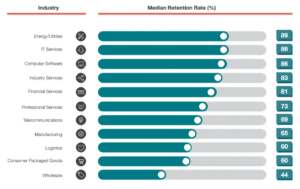
As you can see, CRR can differ between industries. Most businesses, though, will aim for an 85%, which I believe is a great starting point.
Furthermore, if your CRR is below your industry average, you really need to optimize your strategy and find a way to retain more customers. But first, we’ll check some essential KPIs to improve your customer retention strategy.
Essential Metrics To Retain Your Customers
Before moving to the best customer retention practices, let’s see the most important marketing metrics you need to track and how to calculate them:
Purchase Frequency Rate (PFR)
Your PFR shows you how many times an existing customer has bought from you within a given period of time.
Keep in mind that monitoring your PFR will also reveal the level of engagement between shoppers and your brand.
To calculate it, you need to divide the total number of orders made during a time period by the number of existing customers:

For instance, if you have 240 orders and 180 customers, your purchase frequency rate is 1.33.
Compared to your CRR, PFR indicates the value your customers receive from you. Also, you can use the data to identify purchasing habits and improve your promotional efforts and email marketing strategy.
Average Order Value (AOV)
Your AOV is a crucial metric that helps you discover how much each customer spends when they make a purchase.
To find your AOV, you need to divide your total revenue by the number of orders placed:

Monitoring your AOV will help you re-evaluate your pricing model and keep track of the value received by individual customers.
Since your average order value is tied to your company’s performance, calculating it frequently and analyzing the results will ensure your business’s prosperity.
Customer Lifetime Value (CLV)
When we talk about CLV or CLTV, we refer to the amount of money a customer is projected to invest in a business throughout their lifecycle.
CLV is among the most important marketing metrics you need to discover your customer acquisition and retention cost.
To calculate it, you need to divide your average revenue per user (ARPU) by your churn rate:

Finding your ARPU & Churn Rate
First of all, you can measure your ARPU by dividing the revenue generated during a specific period of time by the number of active users.
ARPU = total revenue : # of active users
For your customer churn rate, you have to measure the number of customers at the beginning of the month and subtract the customers remaining at the end of it. Then, divide the sum by the number of customers you had at the beginning.
Churn Rate = # customers at the beginning – # customers at the end : # customers at the beginning
So, if your ARPU equals $25 per customer ($2,000:80 customers) and your churn rate is 5% (80 -76:80 x 100), you’ll get this:
CLV = $25 : 0.05 = $500
Now, if you multiply it by 12 months, you can find your annual CLV (you can change the “months” value based on the time period you want to measure):
Annual CLV = $500 x 12 months = $6,000
Calculating your CLV is essential to determine your customer acquisition cost, which we’ll see below.
Customer Acquisition Cost (CAC)
Your CAC is the amount of money you spend to win over new customers.
To calculate it, you need to divide your sales and marketing cost by the number of new customers:

A good CLV to CAC ratio is usually 3:1, meaning that a customer’s value needs to be three times higher than the acquisition cost.
Knowing your CAC and CLTV will help you keep track of your business. So, if you see that your acquisition cost is more than your CLV, you need to rethink your tactics and focus on retaining existing shoppers more actively.
As we mentioned above, getting old customers to buy is easier than convincing new ones, so keep this in mind when you plan your customer acquisition and retention strategy.
Now to the fun part: learning how to establish meaningful customer relationships that increase both your revenue and brand recognition.
13 Essential Strategies To Retain Your Customers
Building a successful customer retention strategy that delivers exquisite experiences is the best way to nurture shoppers who support you no matter what.
Of course, to make it work, you need the help of some old friends: your email marketing platform, social media, support team, and a few more, which we’ll see right now.
1. Ask Customers to Join your Loyalty Program
You can’t overlook the power that VIP coupons and discounts have. They make you feel special, don’t they?
Consumers love it when brands reward them for buying more. The relationship automatically becomes mutually-beneficial, which is a driver for customer loyalty.
See where we’re going with this? Asking your audience to join your loyalty program. Here’s how it works: the more they purchase, the more you reward them. Basically, it’s an act of appreciation on your side that gives your audience more reasons to buy from you.
What kind of rewards could you offer? Exclusive offers and content, first access to products or services, or free shipping. Whatever you choose, make sure it’s something your audience wants. Tailoring rewards to their needs demonstrates that you focus on giving them a special treatment, not just making them spend more.
So, the first point is to invite them in. What’s next? The best way to engage them right from that initial invitation to any future interaction is through your email marketing campaigns.
With them, you can:
- Highlight the perks of your loyalty program and include loyalty members’ testimonials to build up anticipation
- Welcome them and share your excitement for having them aboard
- Include important information about their points, such as points earned or expiring and remaining balance
- Inform them that they’re close to unlocking the next loyalty status or that they’ve reached it
- Celebrate milestones like their birthday and offer an exclusive deal
Here’s how PetSmart uses the below email to summarize their loyalty member’s activity:
Subject line: Smiles Davis, check out your Treats Rewards summary inside

Of course, running your program manually isn’t viable in the long-run. To put it on autopilot, you’ll need an email marketing platform with marketing automation capabilities.
This way, you can set up a loyalty workflow to deliver follow-up messages when your shoppers’ loyalty points change or you have anything important to share.
If you want to create an effective customer loyalty sequence, sign up for an account and hop into the workflow editor to power up your customer retention.
2. Provide Stellar Customer Service
Solving customer problems is part of your brand’s lifecycle. If you think about it, customer support is one of the first touchpoints for potential customers who have questions about your product/service.
Therefore, providing instant and valuable solutions to common issues differentiates you from your competitors. According to a survey, more then one-half of consumers claimed that they would easily switch to a competitor after a single bad experience with a brand. So, this alone shows us that consumers value great customer experiences more than anything.
And let’s not forget that good customer service is likely to create reciprocity between you and your target audience.
Here’s a real-life example by Dominos, responding to a dissatisfied customer’s public comment on Instagram to direct them to the customer support team:
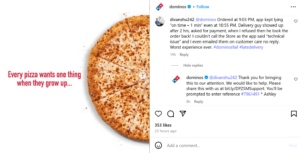
Helping customers before and after they make a purchase is a must to promote brand loyalty. Don’t forget that customers will respond to a positive (or unexpected) experience by sharing it with their peers. This can be the ultimate brand awareness boost.
To provide excellent customer service, you need to streamline your interactions and enhance personalization using CRM Customer Relationship Management software.
Integrate AI-powered live chat support on your website to provide real-time assistance while saving time for your customer support reps to focus on critical cases that call for human-to-human interaction.
Additionally, monitor social media and online reviews to address feedback promptly and ensure a positive, consistent, and tailored customer experience.
In a nutshell, assisting customers works in your favor, allowing you to generate more leads and convert them through the power of word-of-mouth marketing.
3. Invest in Customer Success
Customer Success Management (CSM) is a methodology for ensuring that your audience will get the most out of your product/service and achieve their desired outcome.
Customer success complements your customer service efforts. Most of the times, it aims at being proactive, help you understand customer expectations and determine the experiences your audience wants to have.
To successfully retain your shoppers, connect your CSM software with your CRM database. Through AI, your platform will process the data and give you predictive analytics about your customers’ expectations.
Of course, don’t forget about your customer success team. Your CSM representatives ensure that your audience gets personalized roadmaps with measurable and realistic goals. That way, customers will receive the maximum value through onboarding and training.
And when they do, it’s time for another key responsibility of your CSM team: celebrating customer milestones. Perhaps you decide to send a dedicated email newsletter to let them know you share their excitement for their wins. Also, mention that can’t wait to help them achieve more with your product or service.
These customer accomplishments can also serve as powerful social proof if you decide to feature them on your website, social media, or emails.
So putting together a group of people who will integrate your sales, marketing, training, and support activities is one of the best customer retention initiatives you can take to deliver a seamless experience that sticks with your audience.
4. Re-engage Inactive Customers
Once your loyal customer, now a stranger that doesn’t “talk” to you anymore. But it’s not unnatural for consumers to forget about their favorite brands, especially when real-life responsibilities get in the way. To give them a nudge, create an awesome re-engagement email to show them what they’ve been missing out on.
An effective way of rekindling their interest in your brand involves inspiring subscribers with personalized recommendations. And the more you tailor your messages to their needs, the easier it becomes to win them back.
Also, don’t forget about the immense power of incentives. Offering exclusive discounts or helpful resources as a small incentive won’t just break the first purchase ice but also showcase that you want to provide value.
Here’s a simple yet effective re-engagement email campaign by Animoto, sharing what’s new to spark the reader’s interest:
Subject line: Did you miss out on some of these new features?
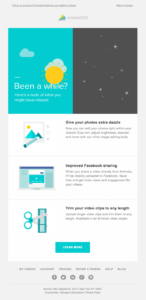
Looking to set up such an email campaign? An easy task thanks to the power of marketing automation. Email marketers can use it to create re-engagement sequences triggered after a specific time of inactivity.
The key with these emails is not to go overboard. Bombarding disengaged subscribers with (probably) unwanted messages is likely to make them walk away once and for all. So, if you that they don’t respond to the first messages, it’s time to think about removing them from your list and focus your attention on the people who want in.
If you are serious about your email re-engagement strategy, join Moosend’s platform to create follow-up sequences that your audience won’t be able to resist.
5. Collect Valuable Customer Feedback
As mentioned, retention is closely linked to positive customer experiences. So the happier your shoppers are, the easier it gets to keep them around-and engaged.
But how do you improve your shoppers’ experiences? It doesn’t have to be just a task for your customer service or success manager. Just ask them what they think about you and your products. The best tactic to collect feedback is to create a customer satisfaction email with a survey and send it to them like Happy Socks did:
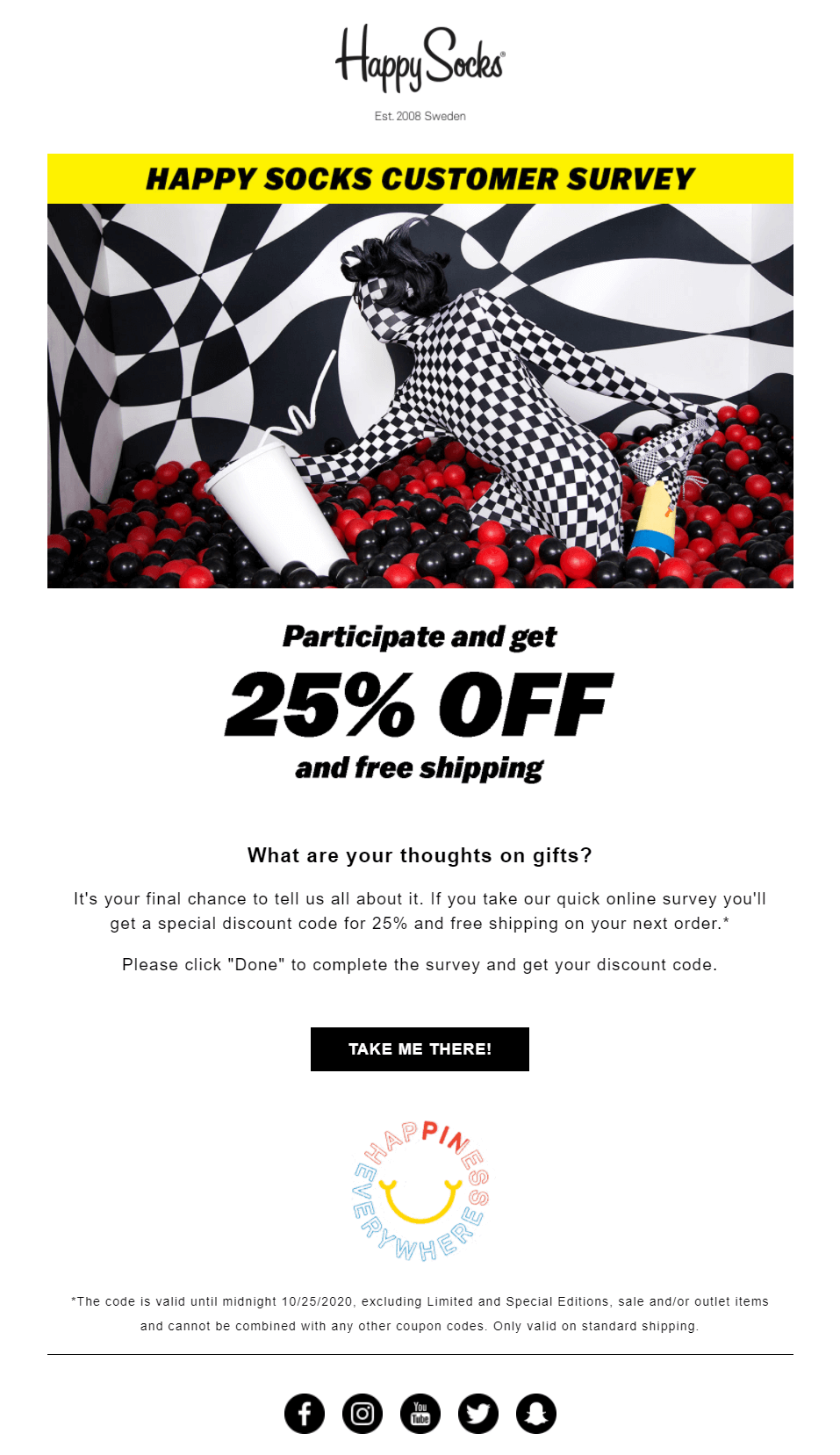
The success of this customer retention strategy lies in customers’ love for sharing their opinion. For those who don’t, getting a 25% off for completing the survey might be that extra nudge they need.
When you create your customer surveys, make sure to ask the right questions that reveal potential issues with your product/service. After analyzing the data, you can address your customers’ concerns with a social media post or another email to show them that you value their feedback.
Don’t limit your inquiries to your products or services, though. Focus on the overall experience instead. For example, reach out after a delivery or customer support communication to learn if everything run smoothly.
If you find that some of your customers aren’t happy, you don’t have to wait until they churn to contact them. Instead, you should identify these customers and reach out to determine what exactly happened and ask them what you can do to turn things around.
Finding the cause of the problem will give you the chance to win them back and improve your customer retention strategy as a whole. Reaching out to these customers through a personal email is the best way to approach them. Just don’t spam them if they aren’t willing to provide feedback.
Customer habits and perceptions change all the time. So collecting info will help you stay up to date and optimize their experience accordingly.
6. Personalize your Email Content
We’re passed the days when subscribers didn’t mind receiving email blasts.
If you want your audience to stay with you, you have to send targeted messages that resonate with them. Thankfully, marketers have many ways to learn more about their customers so they can nail personalized email content.
One of the most common methods to collect audience information is through your subscription forms. As a first step, you’ll probably ask for basic contact info like their name and email address.
Depending on your industry, there are other data that make sense. For instance, a B2B brand could add fields like “Industry” and “Job role”, whereas an eCommerce might prompt the lead to fill in their birthday.
Besides that, use any data at your disposal to deliver personalized email experiences. Think of social media and email interactions, activity on your website, surveys and polls, and communication with your customer service representatives.
And here’s another valuable tool to personalize the experience, and do so on your recipients’ terms: an email preference center for those dormant customers who’d like to opt out from specific email types or change the email frequency.
Leveraging all these insights, you’ll be able to:
- add their name to your subject lines and email copy
- create dynamic content for each recipient
- segment your customers based on their gender, age, location, behavior, and preferences
Duolingo sent a personalized email on the recipient’s anniversary with the brand, including their achievements throughout the year:
Subject line: 🥳 Happy 1st Duoversary, Smiles Davis!
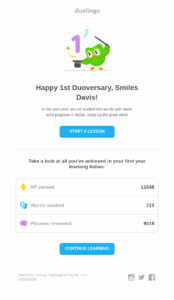
Segmentation and personalization are your best allies to better engagement and sales. So make sure to leverage their power to deliver targeted content to your audience and provide a seamless customer experience.
Want to create targeted customer segments and highly personalized emails that will turn subscribers into repeat customers?
7. Create the Perfect Onboarding Experience
If you want to turn your leads into customers and then loyal advocates, you have to lay a solid foundation. The perfect way to do it is to set up a lead nurturing email sequence that will establish strong relationships with your audience.
During the onboarding period, you should focus on familiarizing newcomers with your value proposition and training them on how to make the most of it. Also, ensure the lines of communication stay open to immediately offer assistance.
Start by designing a welcome email with valuable copy that shows subscribers your true spirit. Then, make sure to infuse your onboarding follow-ups with the right elements:
- Intrigue: Give first-time purchase discounts or free shipping and special offers
- Value: Provide educational content like whitepapers, guides, and case studies.
- Uniqueness: Show them how you differ from your competitors and the ways your product solves their pain points.
That’s exactly what Packlane did, using this onboarding campaign to highlight potential pain points and how the brand’s custom packaging deals with them:
Subject line: Your product’s journey begins here

Moreover, keep in mind that each subscriber will behave differently. So setting up different onboarding sequences based on their actions will increase the chances of engaging them properly.
And don’t neglect following up. Just because you sent the right emails during onboarding doesn’t mean you should disappear right after.
Relationships are forged over time, and when both parties make an effort. So, keep engaging new subscribers with educational content, exclusive deals, and limited-time offers.
The perfect onboarding experience will give you customers for life. And the best part is these shoppers will also help you out by bringing their friends and family over through referrals. That’s two birds with one stone!
8. Power up Brand Credibility
In the era of spam, phishing, and fake ads, consumers wonder whether your company and products are trustworthy. To avoid that and retain customers the right way, you need to increase your credibility.
But this kind of advertising shouldn’t come from your campaigns. Who should do it? Your customers. In other words, you should capitalize on the power of social proof and, more specifically, customer reviews.
When browsing local businesses, 29% of consumers say they always read online reviews and 42% that they do so regularly. People turn to reviews because they think of them as an authentic way to understand whether a product or service brings results.
You can display social proof like reviews, testimonials, or star ratings on strategic places: your home page and product pages, social media, and emails.
This is how Asana features three case studies from enterprise customers on their product page:
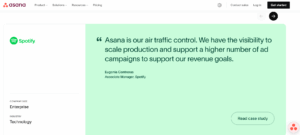
You may ask yourself: “How do I get these positive comments?” First, by keeping your promises and delivering a product that makes your buyers’ lives easier.
Then, you may actively ask for customer feedback through post-purchase email surveys. Or you could run social media contests, encouraging user-generated content. Add a compelling incentive to the mix, and there you have it!
In a nutshell, social proof is your strongest weapon to make your brand more appealing to new visitors.
Use positive customer testimonials on your website, social media, or emails to dissolve any doubt, convert new customers, and give them more reasons to stay in the long haul.
9. Get Customers to Create an Account
Many of your customers have made a purchase as guests. Which is totally fine, and you should always give them that option. But wouldn’t it be better if you knew more about them? (Personalization alert.)
Letting your shoppers check out without an account is convenient. However, when they create one, they can provide you with a ton of extra information about themselves. Which you can later use to personalize your campaigns.
For instance, when a registered user provides you with their birth date, you can use it to create a birthday email campaign with a special offer. Another example is to ask for their location, so you can later send them geo-targeted promotions or invites to local events.
Here’s how Amazon handles account creation:
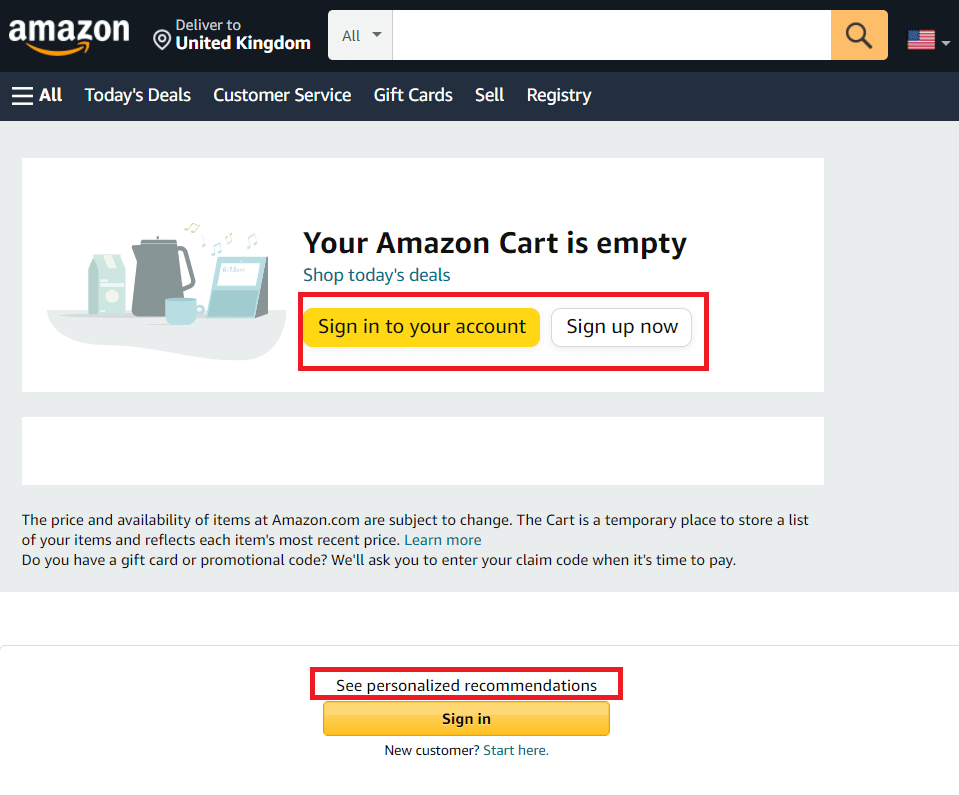
On top of that, Amazon has multiple conversion points to get visitors to sign up. In the last CTA, you can also see how the company adds a little message to show potential customers why they need an account: “See personalized recommendations.”
While this works for Amazon, you can’t really remove the guest option from your checkout because that may inconvenience some users and lead them away. Some people might not have the extra time to spare, some may just be bored, while others could worry about data safety.
Nevertheless, try to get them on board by offering extra incentives like a newsletter signup discount to make the registration process sweeter.
10. Adopt the Subscription Model
A single purchase is great. But what if you could turn it into a regular thing?
Undoubtedly, subscription-based businesses have found the secret to retaining customers simply and effectively. Just look at Netflix. The brand has been using it for years to keep customers paying for its services every single month.
But what about eCommerce stores and retailers? Well, the subscription model could be equally effective there. It’s easy-to-implement, and you can promote it alongside your one-time purchases.
Here’s how Blueland uses it, offering a small discount to incentivize visitors:
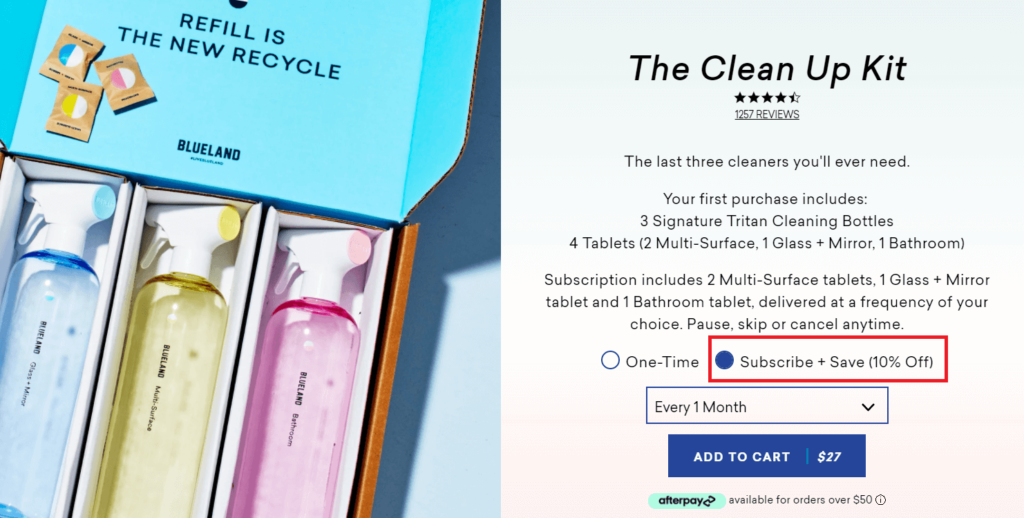
Subscriptions can work well for companies selling goods like cleaning products, coffee, or even smoothies.
Whatever you sell, show your customers why they should opt for a monthly refill. A discount is the best tactic to intrigue them. Giving them freebies is also a smart practice to prompt action. And there’s always priority delivery and support, exclusive events, or early access to new products.
Just make sure that the deal includes something they’d appreciate to keep your customers subscribed.
11. Promote your Brand’s Ideals
Consumers no longer see the company as a legal entity but as a living organism with whom they want to relate. Shared values matter the same in customer relationships like they do in personal ones.
If you want loyal customers, discard the make-a-profit label and adopt a more humanistic approach. It’s an important initiative to make them feel more connected with your business.
To achieve that, you first need to turn the business into a brand. One with a clearly defined mission they can understand and relate to.
Then, use your marketing efforts to show your target audience the reasons why your company is worth their time and money.
Do you fight against discriminations? Are your products eco-friendly? Or do you partner with nonprofits to donate part of your earnings to those in need?
Highlighting your vision and ideals throughout the customer journey motivates potential customers to stick around. For example, Patagonia is a brand that promotes high-quality products that respect the environment:
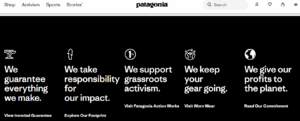
For its customer base, the brand’s mission is one of the reasons for staying. Consumers nowadays prefer to know the origin of the material used to create their favorite garments. So, when a brand takes an eco-friendly approach in product creation while maintaining high quality, it deserves their attention.
But what mostly keeps customers loyal to the brand is Patagonia’s environmental ethos and commitment to protecting humans and wildlife-a common concern for many consumers nowadays.
12. Entertain your Audience
Promoting your products and educating your customers will help you retain them. But do you know what else can win them over? Entertaining content!
Entertaining content is associated with social media. Consumers love checking out new products, looking for secret sales, learn about upcoming contests, and more. What they love more than anything else, though, is watching funny content and sharing it with their friends.
In my opinion, if you make them laugh once, you’re bringing them one step closer to retention. Why? Because people will not only wait for your promo stuff, but also the next laugh. And that’s personal connection at its best.
Brands like Srub Daddy have used unique social media marketing strategies to catch their followers’ attention and give them a good time. This is a small sample of how the company uses its social media towards that goal:

Of course, social media isn’t the only way to go. You can also feature fun and creative content in your email campaigns: relevant emojis, funny GIFs, engaging videos, puns and pop references, and any other element that your audience finds entertaining.
Engaging content will solidify the relationship with your followers and turn into something meaningful. Just make sure that the content you post reflects your brand for a more fulfilling and consistent experience.
13. Don’t Overpromise and Underdeliver
Overpromising is one of the worst mistakes to make as a business. And when this is combined with underdelivering, you can find yourself dealing with frustrated customers and negative noise.
No matter how loyal these shoppers are, a mistake like this can create a backlash. And you definitely don’t want this kind of publicity trending on social media.
Keeping your promises realistic will create reasonable customer expectations that you, in turn, will live up to. And if you actually underpromise and overdeliver, you’ll surprise your audience in a good way.
An honest business creates a feeling of security and reliability that encourages consumers to return for more. So next time you promote a new product or service, keep this in mind to avoid falling into the overpromising/underdelivering trap.
Loyal Customers Ensure Business Growth
To get from customer acquisition to retention, you need to identify your customer’s pain points and provide them with the best solutions.
As demonstrated here, a seamless experience with your brand is all it takes to increase loyalty and turn those first-time shoppers into loyal advocates of your company.
Of course, to achieve retention, you need the help of your CMS, CRM, email marketing, support team, and so on. Also, selecting the best tools for the job will help you streamline your efforts more effectively.
So sign up for a Moosend account to have one thing less to worry about.
Now let me see you off with one of my favorite retention quotes: “I don’t know who you are, but I’ll find you, and I’ll retain you!”
You heard Liam Neeson. It’s time to get your business growth back on track! Oh, and unlike Liam, do make sure you know who your customers are first.
FAQs
1. How can you help customers make the most of your value proposition and retain them?
One of the main strategies to boost customer retention comes by guiding them on how to get more value from your products/services.
So, ensure you create and share educational material like eBooks, how-to guides and videos, webinars, and FAQ articles. Also, have a detailed and up-to-date blog that covers topics relevant to your audience’s pain points.
2. Why do customers churn?
Customers churn when they stop interacting with a business. Here are some of the most common reasons: poor customer service and communication, generic messaging, overpromising and underdelivering.
It might also be that they’ve found a competitive product/service that better meets their needs.
3. Are data linked to customer retention?
There’s no better way to keep your customers around than knowing what drives them, what they fear, and how they think or feel. Getting access to as much insights as you can is a prerequisite for better understanding their likes and dislikes and delivering personalized content and offers.

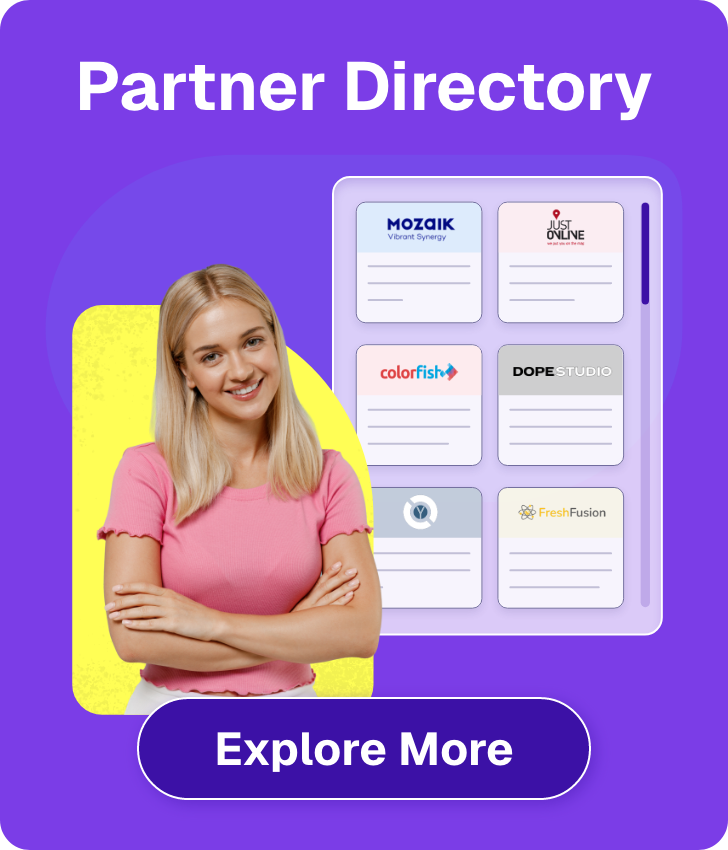

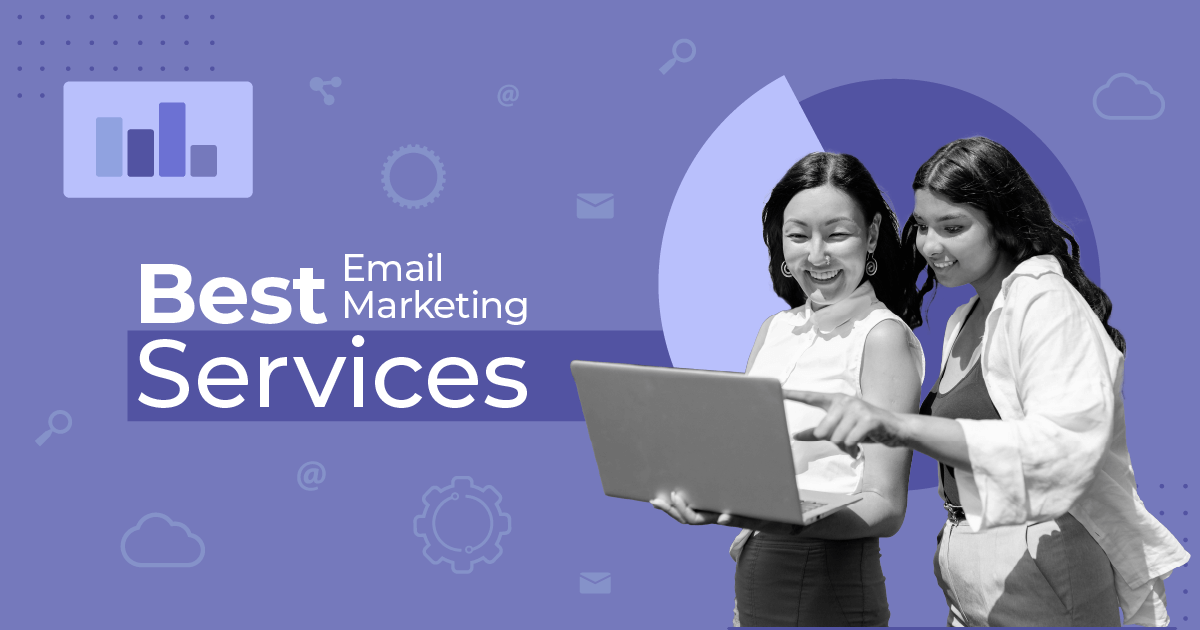
 Published by
Published by
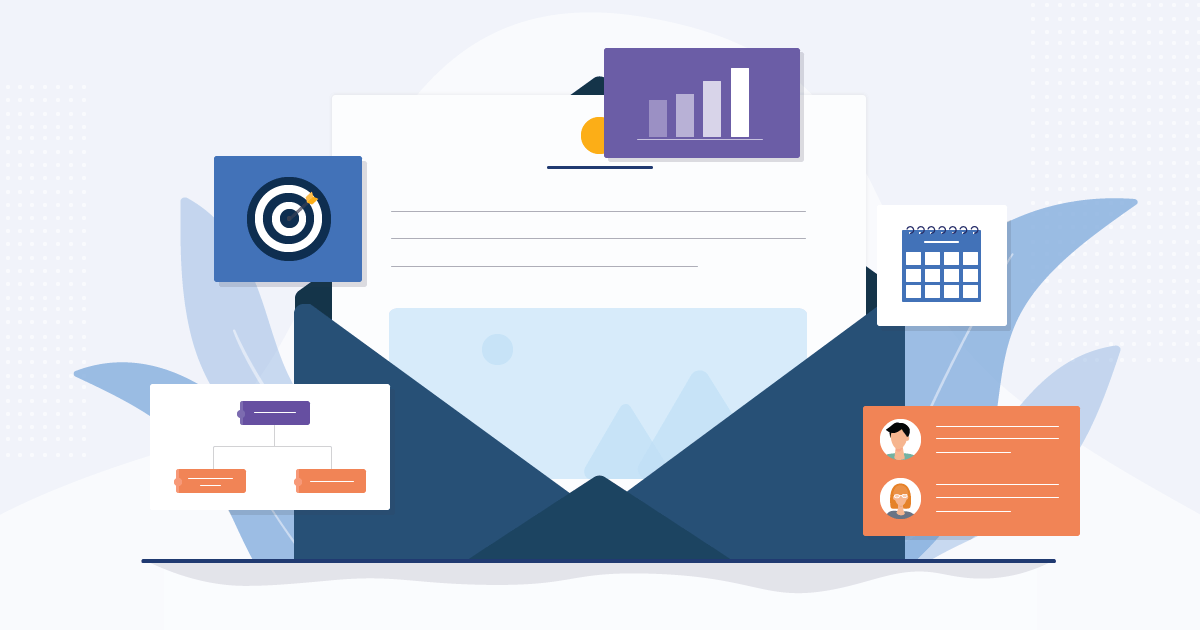

 Published by
Published by